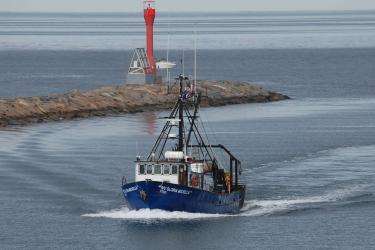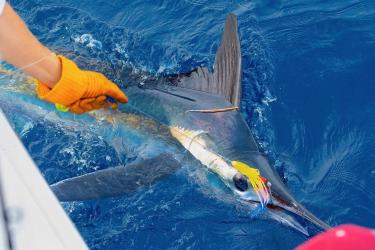Here’s some paper craft fun to celebrate the winter season! Enjoy these downloadable and printable snowflake templates. Decorate your walls, windows, ceiling, holiday tree, and even your holiday cakes. These four designs are inspired by a few of our Woods Hole Science Aquarium residents:
- Black sea bass
- Northern sea robin
- Planehead filefish
- Short big-eye
All you need to do is print the template, grab your scissors, and start folding and cutting. Want to create your own? We’ve got you! We’ve provided a blank template for you to create your own marine life snowflake!
If you’re on Instagram, Facebook or Twitter/X, be sure to post a photo of your snowflake, tag us, and use the hashtag #WHSASnowflakes. We can’t wait to see them! The Woods Hole Science Aquarium is the country's oldest public aquarium and is located in Woods Hole, Massachusetts.
Try them all: download our 2020, 2021, 2022, and 2023 snowflake designs.
Instructions
Print on 8.5 x 11 inch paper.
- Cut the square template from the rest of the printed page.
- Fold your square in half along the black lines to form a triangle. Fold each triangle in half another two times, always ending with the gray design area on top, facing up, and visible.
- Cut away gray areas from the triangle, leaving white areas uncut.
- For the short big-eye template, we recommend using standard hole punch to cut the eye out.
- Gently unfold the cut template to reveal your snowflake.
- Hang in a window or on the wall, from the ceiling, on your holiday tree, or place your template over holiday baked goods, like a cake, and dust with powdered sugar or cocoa powder.
Warning: Snowflake cutting requires the use of scissors. Please carefully supervise children cutting out these templates.
I Want a Black Sea Bass for Christmas
I want a black sea bass for Christmas. Only a black sea bass will do! We agree. Black sea bass are one of the most-loved recreational fish in our region. In fact, In 2022, recreational anglers landed 9 million pounds of black sea bass! This fish can be found along the U.S. East Coast from Cape Cod to the Gulf of Mexico, and prefer structured habitats like reefs, wrecks, or oyster beds. Generally they’ll eat whatever prey is available, but they especially like crabs, shrimp, worms, small fish, and clams.
Some black sea bass fun facts include:
- Black sea bass are usually black, but smaller/younger ones are more of a dusky brown
- During spawning, dominant males turn bright blue and have a blue hump on their heads
- They are protogynous hermaphrodites, meaning most black sea bass start out as females, and as they mature and grow they become males
Aquarium resident fun fact: You can see both juveniles and an adult male (with its head hump) at our aquarium.
Download the black sea bass snowflake template (PDF, 1 page)
It’s a Wonderful Northern Sea Robin
The Northern sea robin is a unique and flamboyant-looking fish with a flat, bony head, bright blue eyes, and large extravagant wing-like pectoral fins. It also has a peculiar set of leg-like appendages that they can move individually. Their pectoral fins have evolved into these appendages. They use them to “walk” along the seafloor and feel and uncover prey like crabs, shrimp, bivalves, and other fish.
New research published this year found that Northern sea robins are quite special and different from other sea robins. Their legs are actually sense organs covered in protrusions called papillae—similar to the taste buds on human tongues. The research team found that the gene responsible for modifying the fin into “legs” was also responsible for developing the papillae to taste prey.
Aquarium resident fun fact: Stanford University’s David Kingsley, one of the coauthors of the study, visited our aquarium in 2016 and saw Northern sea robins. He was wowed by their unique body form. He’d never seen a fish with legs before and thought it was an amazing example of evolutionary innovation. His visit to our aquarium inspired him and his coauthors to study this fish, saying it “sparked whole new areas of modern research.”
Download the Northern sea robin snowflake template (PDF, 1 page)
Not a Creature Was Stirring, Not Even a Filefish
Like all filefish, the planehead filefish are adorably odd looking. Filefish generally have the same form:
- Flattened sidewise like a vertical pancake
- Long pointed snout ending at its small mouth with protruding teeth
- Eyes set high up on the head
- Very stout dorsal spine(s)
This fish can be found on both sides of the Atlantic Ocean. In the Western Atlantic, it can be found from Nova Scotia, Canada, south along the United States, and around Bermuda, the Bahamas, throughout the Gulf of Mexico and Caribbean Sea, and along South America to Uruguay.
Aquarium resident fun fact: Our planehead filefish love mussels and clams.
Download the planehead filefish snowflake template (PDF, 1 page)
Short Big-Eyes With Their Eyes All Aglow
… will find it hard to sleep tonight. Well, that’s probably because short big-eyes are in a family of fish that are nocturnal predators. And their huge eyes look all aglow because of a special membrane behind the retina called the tapetum lucidum. In Latin, it translates to “tapestry or carpet of light.” This membrane acts like a mirror and reflects visible light back through the retina, giving the eye's photoreceptors a second chance to absorb light. This can make their eyes appear as though they’re glowing and is often referred to as “eyeshine.” Basically, this special membrane just helps nocturnal animals see really well in low light conditions.
Aquarium resident fun fact: Some of our short big-eyes were collected in Woods Hole, Massachusetts. Staff easily spotted them because of the fish’s eyeshine.
Download the short big-eye snowflake template (PDF, 1 page)
Create Your Own Snowflake
Do you have a favorite marine animal or plant you’d like to turn into a snowflake? Download our blank template to make your own masterpiece!







